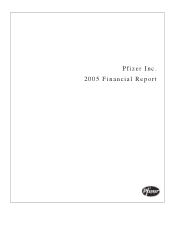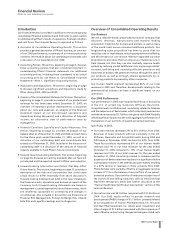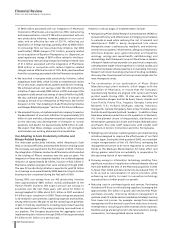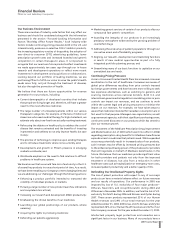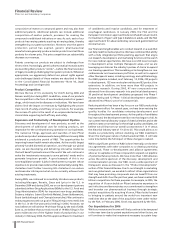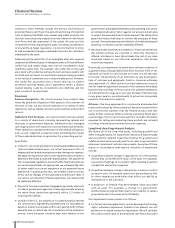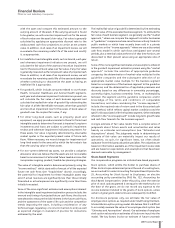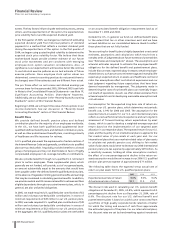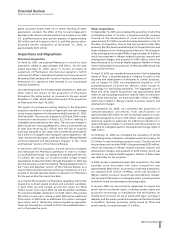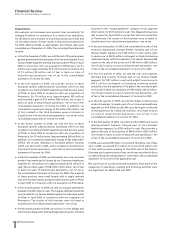Pfizer 2005 Annual Report Download - page 4
Download and view the complete annual report
Please find page 4 of the 2005 Pfizer annual report below. You can navigate through the pages in the report by either clicking on the pages listed below, or by using the keyword search tool below to find specific information within the annual report.
Our Business Environment
There are a number of industry-wide factors that may affect our
business and should be considered along with the information
presented in the section “Forward-Looking Information and
Factors That May Affect Future Results.” Such industry-wide
factors include continuing pricing pressures both in the U.S. and
internationally, pressures on selective COX-2 inhibitor products,
the increasing regulatory scrutiny of drug safety, the adoption of
new direct-to-consumer (DTC) advertising guidelines, lower
prescription growth rates and increased branded and generic
competition in certain therapeutic areas. It is important to
recognize that our near-term future products reflect investments
we made approximately ten years ago through our in-house
research and development operations or reflect more recent
investments in development and acquisitions or collaborations.
Looking beyond our portfolio of leading medicines, we are
positioning Pfizer to fulfill our vision to serve the public’s health
needs more fully, not just through the treatment of diseases,
but also through the promotion of health.
We believe that there are future opportunities for revenue
generation for our products, including:
•Current demographics of developed countries that indicate
that people are living longer and, therefore, will have a greater
need for the most effective medicines;
•The large number of untreated patients within our various
therapeutic categories. For example, of the tens of millions of
Americans who need medical therapy for high cholesterol, we
estimate only about one-fourth are actually receiving treatment;
•Refocusing the debate on health policy to address the cost of
disease that remains untreated and the benefits of investing
in prevention and wellness to not only improve health, but save
money;
•The promise of technology to improve upon existing therapies
and to introduce treatments where none currently exist;
•Developments and growth in Pfizer’s presence in emerging
markets worldwide; and
•Worldwide emphasis on the need to find solutions to difficult
problems in healthcare systems.
We have known that we would face loss of exclusivity in the U.S.
of several key products in a very short period of time. As a result,
we have been remaking our Company to meet changing times and
we are addressing our challenges through the following actions:
•Enhancing a product portfolio intended to transcend the
volatility of individual products or markets;
•Pursuing a large number of new product launches, indications
and completed clinical trials;
•Increasing our research and development (R&D) productivity;
•Emphasizing the clinical benefits of our medicines;
•Launching new global positionings of our products, where
necessary;
•Acquiring the rights to promising medicines;
•Defending our patents aggressively;
•Marketing generic versions of certain of our products after our
compounds face generic competition;
•Guarding the integrity of our products in an increasingly
predatory atmosphere evidenced by the growing problem of
counterfeit drugs;
•Addressing the wide array of patient populations through our
innovative access and affordability programs;
•Aligning our research, development and marketing functions
in search of new medical opportunities as part of a fully
integrated portfolio-planning process; and
•Streamlining many of our basic functions to capitalize on our
unmatched size and reach.
Continuing Pricing Pressures
A rise in Consumer Directed Health Plans has increased consumer
sensitization to the cost of healthcare. Consumers are aware of
global price differences resulting from price controls imposed
by foreign governments and have become more willing to seek
less expensive alternatives, such as switching to generics and
sourcing medicines across national borders. Both U.S. and
international governmental regulations mandating prices or price
controls can impact our revenues, and we continue to work
within the current legal and pricing structures to minimize the
impact on our revenues. For example, we have taken steps to
assure that medicines intended for Canadian consumption are in
fact used for that purpose. Managed care organizations, as well
as government agencies, with their significant purchasing power,
continue to seek discounts on our products which has served to
slow our revenue growth.
The enactment of the Medicare Prescription Drug Improvement
and Modernization Act of 2003 (which went into effect in 2006)
regarding prescription drug benefits for Medicare beneficiaries
expands access to medicines that patients need. While expanded
access may potentially result in increased sales of our products,
such increases may be offset by increased pricing pressures due
to the enhanced purchasing power of the private sector providers
that will negotiate on behalf of Medicare beneficiaries in the
future. We believe that our medicines provide significant value
for both providers and patients not only from the improved
treatment of diseases, but also from a reduction in other
healthcare costs such as hospitalization or emergency room costs,
increased patient productivity and a better quality of life.
Defending Our Intellectual Property Rights
The loss of patent protection with respect to any of our major
products can have a material adverse effect on future revenues
and our results of operations. Our performance in 2005 was
impacted by loss of U.S. exclusivity of four major products—
Diflucan, Neurontin, and Accupril/Accuretic during 2004 and
Zithromax in November 2005. In addition, we face the loss of U.S.
exclusivity for Zoloft during 2006 and Norvasc and Zyrtec during
2007. These seven products represented 33% of our Human
Health revenues and 29% of our total revenues for the year
ended December 31, 2004. Zithromax, Zoloft, Norvasc and Zyrtec
represented 26% of our Human Health revenues and 22% of our
total company revenues for the year ended December 31, 2005.
Intellectual property legal protections and remedies are a
significant factor in our business. Many of our products have a
2005 Financial Report 3
Financial Review
Pfizer Inc and Subsidiary Companies

